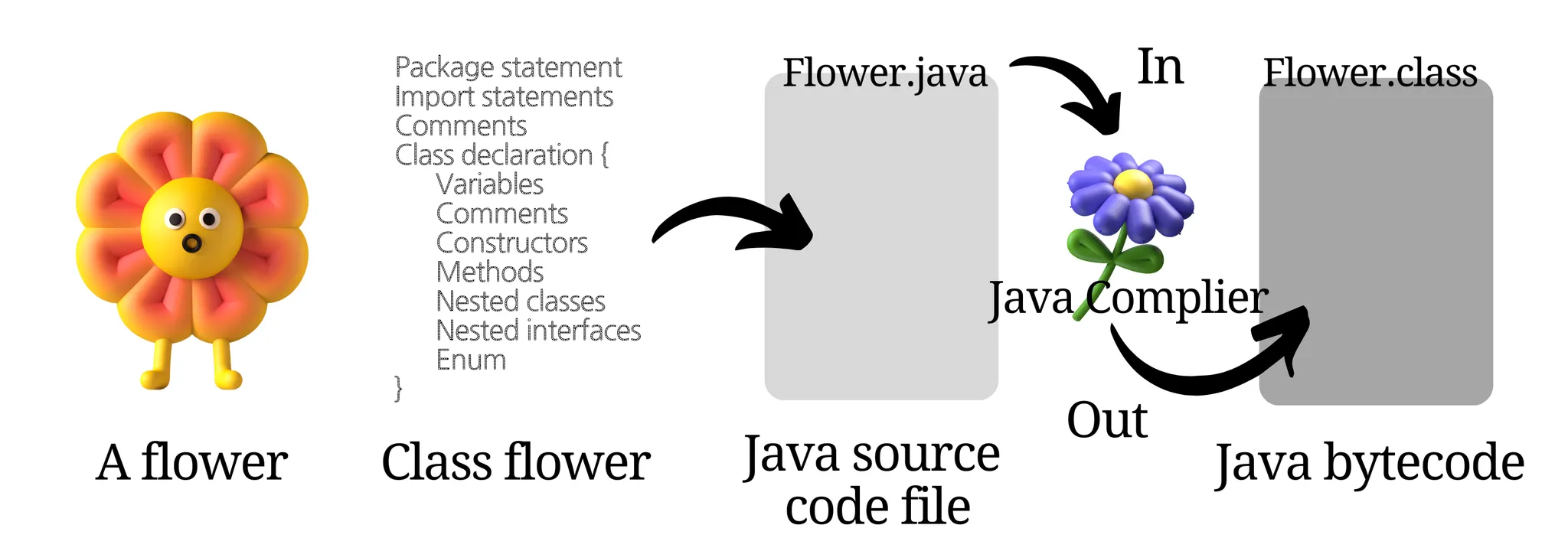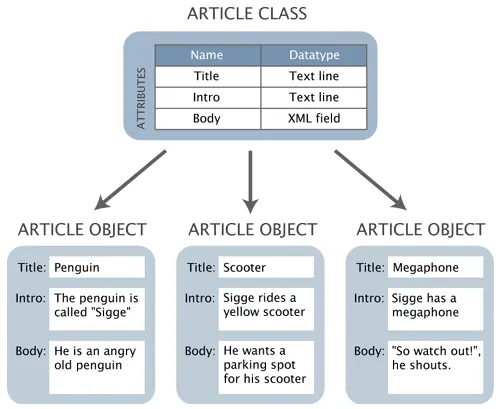Class
What is class?
클래스를 간단하게 말하자면 ‘청사진’ 이라 할 수 있다. 말그대로 우리가 집어넣을 new data type(instance) 과 그 데이터가 어떻게 행동할지를 말해주는 것이다.
구조를 간단하게 그리면 다음과 같다.
[예시 코드]
public class Store {
// instance fields
String productType;
int inventoryCount;
double inventoryPrice;
// constructor method
public Store(String product, int count, double price) {
productType = product;
inventoryCount = count;
inventoryPrice = price;
}
// main method
public static void main(String[] args) {
Store lemonadeStand = new Store("lemonade", 42, .99);
Store cookieShop = new Store("cookies", 12, 3.75);
System.out.println("Our first shop sells " + lemonadeStand.productType + " at " + lemonadeStand.inventoryPrice + " per unit.");
System.out.println("Our second shop has " + cookieShop.inventoryCount + " units remaining.");
}
}
Java
복사
Store 라는 클래스 안에는 다양한 데이터 타입들이 지정되어 있다. 또한 메인 method 외에도 다른 method 도 있는 것을 확인 할 수 있다. 이 클래스를 실행한다면 결과는 어떻게 나올까?
Output
Our first shop sells lemonade at 0.99 per unit.
Our second shop has 12 units remaining.
Object
위 예시의 출력문을 보자. 클래스 안에는 실제 값이 아닌 다양한 데이터 타입들이 지정되어 있다고 했다. 그렇다면 레모네이드의 가격 등과 같은 실제 값은 뭐라고 불러야 할까? 바로 object 이다.
클래스와 오브젝트의 구조도를 보면 대략 다음과 같다.
즉, Class 는 청사진으로, Object 는 구현할 대상이라고 보면 된다. 클래스의 인스턴스 라고도 불린다.
 Instance 란?
Instance 란?
Class 를 바탕으로 오브젝트에 구현된 구체적인 실체이며, 원본으로부터 생성된 복제본을 말한다. 이 실체화 된 인스턴스는 메모리에 할당 된다.
Syntax of Class
public class example {
// 클래스 이름은 자바 파일과 같이 해줘야 한다.
public static void main(String[] args){
// main 문 없이는 돌아가지 않는다!
}
}
Java
복사
Constructors
객체(클래스의 instance) 를 만들기 위해서는 Constructor method 가 필요하며, Constructor는 클래스 안에 정의되어 있다.
[예시 코드]
public class Car {
// Constructor method
public Car() {
// instructions for creating a Car instance
}
public static void main(String[] args) {
// body of main method
}
}
Java
복사
instance 를 만들기 위해서는 메인 메서드 안에서 constructor 를 호출해야 한다.
[예시 코드]
public class Car {
public Car() {
// instructions for creating a Car instance
}
public static void main(String[] args) {
// Invoke the constructor
Car ferrari = new Car();
}
}
Java
복사
예시에서 변수 ferrari 는 reference data type 이다. 즉 인스턴스 메모리 주소의 reference 이다. 정의를 내릴 때의 구문은 다음과 같다.
[클래스명] [변수이름] = new [constructor name]();
여기서 new 라는 키워드를 생략하면 에러가 나타나게 된다.
위와 같은 구문을 통해 Car instance 를 ferrari 라는 변수로 지정할 수 있다.
이 변수를 출력하면 우리는 ferrari 의 메모리 주소를 알 수 있다.
 만약 reference를 null로 지정한다면 어떻게 될까?
만약 reference를 null로 지정한다면 어떻게 될까?
null 은 값을 가지고 있지 않다. 만약 null 을 object 로 지정한다면 그 object 는 void reference 가 될것이다. 아래와 같이 Car 이라는 instance 를 만들고, reference 를 지정한 뒤에 그 값을 null 로 바꿔보자.
[예시 코드]
Car thunderBird = new Car();
System.out.println(thunderBird); // Prints: Car@76ed5528
thunderBird = null; // change value to null
System.out.println(thunderBird); // Prints: null
Java
복사
차이가 보이는가?
[한걸음 더]
만약 메서드를 부르거나 instance 변수에 접근하기 위해 null reference 를 이용한다면 어떻게 될까? 우리는 NullPointerException 에러를 보게 될 것이다. 
 코드를 보면서 실행 순서 이해하기
코드를 보면서 실행 순서 이해하기
[예시 코드]
public class Store {
// new method: constructor!
public Store() {
System.out.println("I am inside the constructor method.");
}
// main method is where we create instances!
public static void main(String[] args) {
System.out.println("Start of the main method.");
// create the instance below
Store lemonadeStand;
lemonadeStand = new Store();
// print the instance below
System.out.println(lemonadeStand);
}
}
Java
복사
1.
메인 메서드를 실행한다.
2.
instance를 만들었기 때문에 메인 메서드에서 Store constructor로 이동한다.
3.
Store 메서드가 실행이 된다.
4.
Store 메서드의 실행이 끝나면 다시 메인 메서드로 돌아와 출력을 하게 된다.
Instance Fields
instance 변수나 instance fields 를 설명하기 위해 우리는 object 에 데이터를 추가한다. 그렇다면 여기서 instance fields 란 무엇일까? 아래의 코드를 보면 쉽게 이해 가능하다.
[예시 코드]
public class Car {
/*
declare fields inside the class
by specifying the type and name
*/
String color;
public Car() {
/*
instance fields available in
scope of constructor method
*/
}
public static void main(String[] args) {
// body of main method
}
}
Java
복사
단어 뜻 그대로 영역이다. 이 영역이 어디에 위치해 있느냐에 따라 영향을 미치는 곳이 다르다.
Constructor Parameters
dynamic, individual 상태의 object를 만들기 위해 constructor method 와 인스턴스 필드를 이용한다.
잘 생각해보면 우리는 이미 메인 메서드에서 파라미터를 본 적이 있다. String[] args 가 바로 그것이다. 메인 메서드 말고 다른 constructor 메서드에 있는 파라미터를 아래의 예시에서 확인해보자.
[예시 코드]
public class Car {
String color;
// constructor method with a parameter
public Car(String carColor) {
// parameter value assigned to the field
color = carColor;
}
public static void main(String[] args) {
// program tasks
}
}
Java
복사
여기서 String carColor는 parameter 이며, color 는 constructor 메서드 외부에서 지정된 변수이다. 이 변수의 값을 contstructor 메서드 안에서 지정하기 위해서 parameter 를 사용했다. 그렇게 해야 인스턴스에 지정하기 원하는 데이터에 접근할 수 있기 때문이다.
 Formal parameter
Formal parameter
formal parameter 는 데이터의 타입이나 이름과 같은 값을 명시하며, 이는 메서드를 통과 할 수 있다. 위의 예시에서 찾아본다면, String carColor 가 되겠다. carColor 는 constructor 메서드를 통과하는 String 형태의 어떠한 값이든 대표할 것이다.
자바에서는 한 클래스가 여러개의 constructor를 가지는 것도 가능하다. 대신 다른 parameter 를 가져야 한다. 아래의 예시를 보자.
[예시 코드]
public class Car {
String color;
int mpg;
boolean isElectric;
// constructor 1
public Car(String carColor, int milesPerGallon) {
color = carColor;
mpg = milesPerGallon;
}
// constructor 2
public Car(boolean electricCar, int milesPerGallon) {
isElectric = electricCar;
mpg = milesPerGallon;
}
}
Java
복사
위의 예시를 보면 두개의 constructor 가 있다는 것을 알 수 있다. 만약에 object 를 실행한다면 complier 는 argument 의 타입과 constructor 의 시그니처를 비교 해보고 어떤 constructor 을 사용할 것인지 판단 한다.
만약 constructor 를 정의하지 않았다면 자바 컴파일러는 아무런 argument 도 포함하지 않는 디폴트 생성자를 생성하고 디폴트 값을 지정할 것이다. 디폴트 값은 선언하는 동안 인스턴스 필드에 지정된 값에 의해 만들어 진다.
[예시 코드]
public class Car {
String color = "red";
boolean isElectric = false;
int cupHolders = 4;
public static void main(String[] args) {
Car myCar = new Car();
System.out.println(myCar.color); // Prints: red
}
}
Java
복사
예시를 보면 constructor 도 없고, 이 때문에 constructor 를 호출할 argument 도 없다는 것을 알 수 있다.
메서드의 파라미터와 이름을 정의하는것을 말한다.
위 예시 에서는 Car(String carColor, int milesPerCallon) 이 해당된다.
단어 | 번역 | 의미 |
Parameter | 매개변수 | 메서드 입력 변수(Variable) 명 |
Argument | 전달인자, 인자 | 메서드를 호출 할 때의 입력 값(Value) |
Assigning Values to Instance Fields
예시를 먼저 보고 순서를 잘 이해해 보자!
[예시 코드]
public class Car {
String color;
public Car(String carColor) {
// assign parameter value to instance field
color = carColor;
}
public static void main(String[] args) {
// parameter value supplied when calling constructor
Car ferrari = new Car("red");
}
Java
복사
생성자 Car 의 호출로 인해 “red” 라는 스트링 값을 전달할 것이다. 이때 “red” 라는 값의 타입은 반드시 파라미터의 타입과 일치해야 한다. 일치 한다면, 생성자 Car 안에서 파라미터는 인스턴스 영역에 있는 color 에 지정될 것이다. color 는 첫부분에 어떤 타입을 가지는지 선언이 되었기 때문에 따로 타입을 지정 해 줄 필요는 없다. 결론적으로 객체 ferrari 는 “red” 라는 값을 color 의 상태로 가지고 있다. 만약에 이 값에 접근하고 싶다면 아래와 같이 선언하면 된다.
[예시 코드]
/*
accessing a field:
objectName.fieldName
*/
ferrari.color;
// "red"
Java
복사
Actual parameter 나 argument 는 메서드가 호출되는 동안에 전달되는 값을 말한다. argument 값을 이용하여 호출을 할 때, argument 가 전달되면 formal parameter 는 argument 값을 복사하여 이를 처음 값으로 삼는다.
Multiple Fields
객체는 필요에 따라 여러가지 인스턴스 영역을 가질 수 있다. 아래의 예시를 보자.
[예시 코드]
public class Car {
String color;
// new fields!
boolean isRunning;
int velocity;
// new parameters that correspond to the new fields
public Car(String carColor, boolean carRunning, int milesPerHour) {
color = carColor;
// assign new parameters to the new fields
isRunning = carRunning;
velocity = milesPerHour;
}
public static void main(String[] args) {
// new values passed into the method call
Car ferrari = new Car("red", true, 27);
Car renault = new Car("blue", false, 70);
System.out.println(renault.isRunning);
// false
System.out.println(ferrari.velocity);
// 27
}
}
Java
복사
예시에서의 생성자는 새로운 영역의 값을 받기 위한 다수의 파라미터를 가지고 있으며, 각각의 타입도 명시되어 있다. 메인 메서드에서 생성자를 호출하기 위해 인스턴스를 생성할 때는 반드시 파라미터의 순서와 똑같이 값을 넣어줘야 한다.
추상화 기법
Methods
What is Methods?
메서드는 특정한 일을 달성하기 위해 반복적으로 사용되는 코드 블록이다. 많은 일을 한번의 메서드로 실행하기에는 무리가 있기 때문에 메서드 분해를 통해서 작고, 특정한 일들을 동시에 수행한다.
개인적으로 코딩을 하기 보다는 일터에서 협업을 하는 경우가 많아질 것이다. 이때 모든 사람들이 특정 메서드가 어떻게 작동하는지는 알 필요가 없다. 대신 어떤 경우에 어떤 메서드를 사용하는지는 알아야 한다. 이를 procedural abstrction 이라고 한다.
Defining Methods
용어 정리
Calling Methods
객체에 매서드를 호출해야 매서드가 수행된다. 호출할 때에는 다음과 같은 구문을 이용한다.
[객체명].[호출 할 메서드명]();
코드는 일반적으로 탑다운 방식으로 실행된다. 그러나 메서드의 경우, 호출되지 않는 이상 컴파일러가 무시한다. 만약 호출 되었다면 컴파일러는 메서드 안에 있는 모든 내용들이 탑다운 방식으로 진행된다.
Scope
매서드는 클래스의 객체가 실행해야할 일이라고 할 수 있다. 이 일의 범위는 { } 로 지정된다. 이것을 매서드의 범위 라고 부른다. 이 범위 밖의 변수에는 접근 할 수 없다는 것을 명심하자!
Adding Parameters
메서드의 파라미터 리스트가 다른 메서드들과 다르다면 메서드 명은 같아도 된다.
[예시 코드]
// Method 1
public void startRadio(double stationNum, String stationName) {
System.out.println("Turning on the radio to " + stationNum + ", " + stationName + "!");
System.out.println("Enjoy!");
}
// Method 2
public void startRadio(double stationNum) {
System.out.println("Turning on the radio to " + stationNum + "!");
}
public static void main(String[] args){
Car myCar = new Car("red");
// Calls the first startRadio() method
myCar.startRadio(103.7, "Meditation Station");
// Calls the second startRadio() method
myCar.startRadio(98.2);
}
Java
복사
Returns
변수들은 선언된 범위 내에서만 존재할 수 있다. 하지만 메서드에 리턴 키워드가 있는 경우, 메서드로 부터 리턴 받은 값을 범위 밖에서도 쓸 수 있다.
[예시 코드]
public int numberOfTires() {
int tires = 4;
// return statement
return tires;
}
Java
복사
이 메서드에서는 4 라는 값을 반환 할 것이다. 리턴 구문이 실행되면 complier 는 함수를 실행 시키는데, 이때 리턴 문장 이후에 있는 코드들은 무시한다.
 만약 새로 만든 메서드가 void 인 경우 어떻게 해야할까?
만약 새로 만든 메서드가 void 인 경우 어떻게 해야할까?
void 는 비어있음을 의미한다. 즉, 메서드가 호출 된 이후에 반환 될 값이 없다는 것이다. 이럴 때에는 리턴 타입을 명시해 줘야 하기때문에 void 를 리턴 타입으로 바꾸어 주어야 한다.
non-void 메서드의 경우 아래와 같이 쓰일 수 있다.
[예시 코드]
public static void main(String[] args){
Car myCar = new Car("red");
int numTires = myCar.numberOfTires();
}
Java
복사
메인 메서드 안에 있는 myCar 에 numberOfTires() 메서드를 호출 할 수 있다. 메서드가 4라는 값을 반환 한 이후에는 numTires 라고 불리는 변수 안에 복사된 값인 4가 저장 될 것이다.
 메서드의 primitive 값이 아닌 객체의 값을 반환하면 어떻게 될까?
메서드의 primitive 값이 아닌 객체의 값을 반환하면 어떻게 될까?
[예시 코드]
class CarLot {
Car carInLot;
public CarLot(Car givenCar) {
carInLot = givenCar;
}
public Car returnACar() {
// return Car object
return carInLot;
}
public static void main(String[] args) {
Car myCar = new Car("red", 70);
System.out.println(myCar);
CarLot myCarLot = new CarLot(myCar);
System.out.println(myCarLot.returnACar());
}
}
Java
복사
primitive 값은 값의 복사본이 반환된다. 하지만 객체를 반환 할 경우, 객체의 복사본 대신에 객체를 참조 한다. 위의 예시를 보면 carInLot 이라는 클래스는 Car 을 파라미터(변수명) 로 쓴다. 그리고 Car 객체를 반환하는 메서드를 포함 한다. 이 코드를 출력해보면 같은 메모리 주소를 사용하고 있음을 알 수 있다. 왜냐하면 myCar 과 carInLot 이 둘다 똑같은 참조형 값을 가지고 있기 때문이다.
The toString() Method
객체를 출력하면 객체의 메모리상 위치가 결과로 나오는 것을 알 수 있다. 하지만 toString() 메서드를 이용하면 객체를 출력 할 수 있다.
[예시 코드]
class Car {
String color;
public Car(String carColor) {
color = carColor;
}
public static void main(String[] args){
Car myCar = new Car("red");
System.out.println(myCar);
}
public String toString(){
return "This is a " + color + " car!";
}
}
Java
복사
Constructor VS Methods
Constructor
(1) 어떠한 값도 반환하지 않지만 void 를 사용하지는 않는다.
(2) 주로 객체를 초기화 하는 데 사용하며, 인스턴스를 생성할 때 실행되어야 할 작업을 위해서 사용되기도 한다.
(3) 클래스 내에 선언되며, 클래스의 이름과 같아야 한다.
(4) 다른 메서드들과 같이 오버로딩이 가능하기 때문에 하나의 클래스는 여러가지 생성자를 가질 수 있다.
(5) new 를 통해서 인스턴스를 생성하고, 생성자는 인스턴스 생성 시 초기화에 사용된다.
(6) 종류
1.
No Argument 생성자
2.
파라미터가 있는 생성자
3.
디폴트 생성자
아무 매개변수도 없고 내용도 없는 생성자이다. 클래스에 구현된 생성자가 없다면 기본 생성자가 추가되어 컴파일 된다.(만약 접근 제한자가 public 인 경우 public 제한자가 붙은 기본생성자가 추가된다.)
Methods
(1) 클래스의 생성자와 같은 이름을 가질 수 없다.
(2) 메서드는 void 를 포함해, 반환 값을 가지고 있다.
(3) 자바 컴파일러는 디폴트 메서드를 제공하지 않는다.
(4) 상속과 재정의 기능은 non-static 메서드의 특징이다.
(5) 객체(non-static 메서드의 경우), 클래스 참조(static 메서드의 경우), 메서드 이름을 이용하여 메서드를 호출할 수 있다.
(6) 객체의 작동을 구체화 하기 위해 사용된다.




